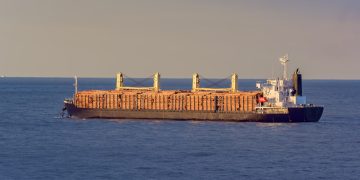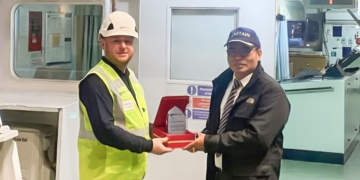As part of IMCA’s recently published Safety Flashes, it is described a case where a crane whip line parted during hook stop testing.
The incident
The crane was positioned in the rest while the Crane Operator carried out hook stop testing of the auxiliary winch.
An uncontrolled hoisting movement resulted in the headache ball striking the jib and falling with the hook stop rigging assembly back to deck.
The Crane Operator was testing both the main winch and the auxiliary winch. The main winch was tested and operated normally.
[smlsubform prepend=”GET THE SAFETY4SEA IN YOUR INBOX!” showname=false emailtxt=”” emailholder=”Enter your email address” showsubmit=true submittxt=”Submit” jsthanks=false thankyou=”Thank you for subscribing to our mailing list”]
When the Crane Operator started to test the auxiliary winch, the winch accelerated to full speed pulling the headache ball into the sheave.
The headache ball collided with the jib and the wire snapped, approximately 19 meters from the headache ball. The headache ball (500kg) and the hook stop rigging (25kg) dropped 4.2 meters to deck. There were no personnel in the vicinity.
Probable causes
- The winch was actuated by two hydraulic motors and the speed of the motors measured by encoders. The
encoders were badly corroded inside and within the circuit board which resulted in erroneous signal being sent.Both speed encoders required replacement. The crane software was updated to include a second barrier
preventing wrong signals from the encoder. - The winch wire was in poor condition, corroded and dry. The investigation identified deviations from the wire
rope management requirements of both the company and the owner of the vessel. - The auxiliary winch wire was the original wire installed on the winch and had been in service for approximately 7.5 years. Magnetic Rope Tests (MRT) were performed every second year with wire cut-back completed in accordance with the recommendations from the examination. The latest MRT was not completed successfully due to failure in the test equipment and was overdue at the time of the incident. The wire used was 2160 grade which is vulnerable to brittleness; the company does not accept this grade if it is avoidable.
- The risk for using the wire had been identified however, it was not supported by a Management of Change
(MoC) and risk assessment and so no corrective action taken.
Lessons learned
- Check and see if this same encoder component fault can occur on your worksite and check the maintenance
routines for encoders. - Further asssure the integrity of wire ropes by carrying out a thorough visual examination combined with either annual Destruction Test or MRT Traces.
- Identify the age of the wire ropes and confirm appropriate in-service reviews have been carried out.
- Ensure formal MoC process is followed where compliance with existing procedures is not possible.
- Review risk assessment for the crane start-up process and ensure that safe positioning of personnel and
associated controls are an included control requirement.
See also
Lessons learned: Failure of emergency stop on rescue boat winch

































































